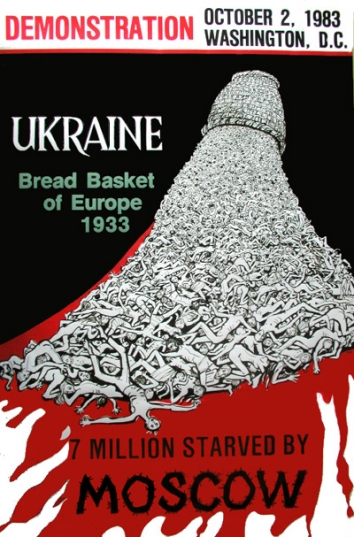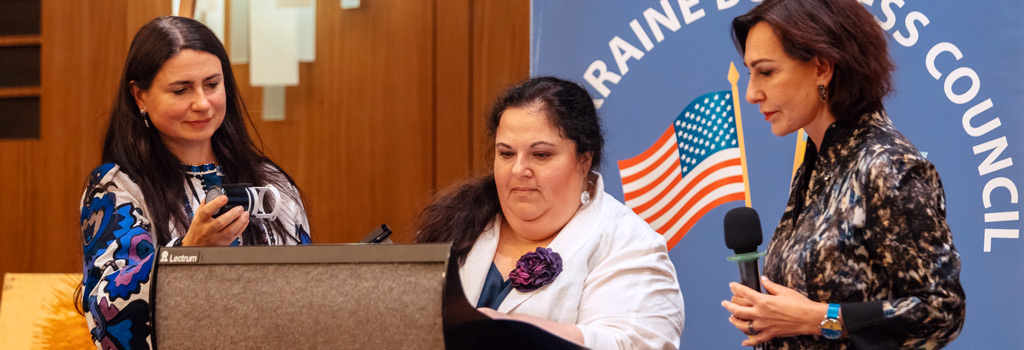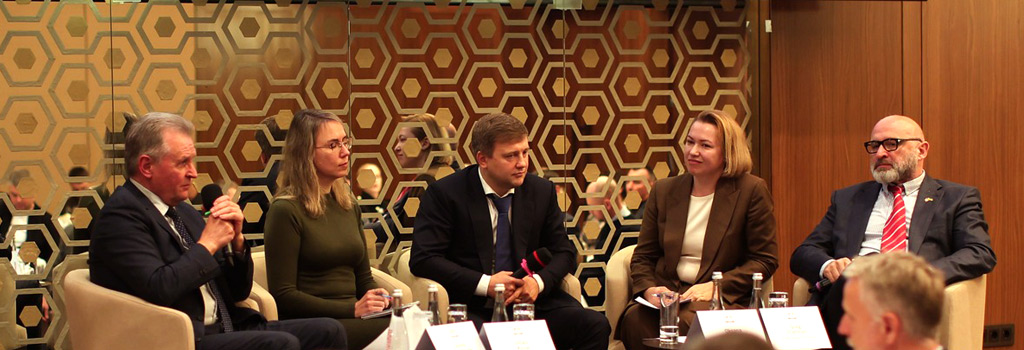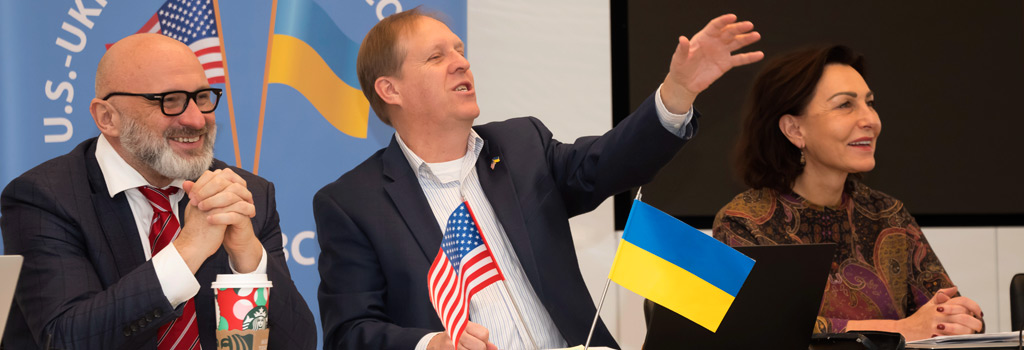Featured Galleries USUBC COLLECTION OF OVER 160 UKRAINE HISTORIC NEWS PHOTOGRAPHS 1918-1997
 Holodomor Posters
Holodomor Posters

UKRAINE - MACROECONOMIC SITUATION – JULY 2017
 ANALYTICAL REPORT: by Oleg Ustenko, Djulia Segura, Valentyn Povroznyuk, Edilberto L. Segura
ANALYTICAL REPORT: by Oleg Ustenko, Djulia Segura, Valentyn Povroznyuk, Edilberto L. Segura
SigmaBleyzer private equity investment management firm & The Bleyzer Foundation (TBF), Kyiv, Ukraine
LINK: Ukr_Monthly_Ec_Report_July_2017.pdf
Published by U.S.-Ukraine Business Council (USUBC),
Washington, D.C., Tue, Sep 5, 2017
ANALYTICAL REPORT: by Oleg Ustenko, Julia Segura, Valentyn Povroznyuk, Edilberto L. Segura SigmaBleyzer multinational private equity firm & The Bleyzer Foundation (TBF), Kyiv, Ukraine
ANALYTICAL REPORT: by Oleg Ustenko, Julia Segura, Valentyn Povroznyuk, Edilberto L. Segura SigmaBleyzer multinational private equity firm & The Bleyzer Foundation (TBF), Kyiv, Ukraine Published by the U.S.-Ukraine Business Council (USUBC), Washington, D.C., Tue, Sep 5, 2017
WASHINGTON, D.C. - The "Ukraine Macroeconomic Situation – July 2017" analytical report is found below and as an attachment to this communication. The monthly macroeconomic situation report is prepared by the SigmaBleyzer multinational private equity firm, www.SigmaBleyzer.com, and The Bleyzer Foundation (TBF), www.BleyzerFoundation.org, Kyiv, Ukraine, who are members of the U.S.-Ukraine Business Council (USUBC), http://www.USUBC.org.
NOTE: The complete Ukraine - Macroeconomic Situation - report for July 2017 in PDF format, with a series of important, color charts and graphs, can be found in the attachment to this e-mail.
EXECUTIVE SUMMARY -----
(1) Despite the agreement reached in June in Minsk on a temporary armistice until August 31st, Russian backed separatists continued their attacks against Ukrainian militants and civilians. The parts of
Luhansk and Donetsk under government control are under constant attacks from the separatists. The daily number of attacks in July varied from 10 to 30.
(2) Ukraine continues to implement its reform agenda. The main item in the country’s reform agenda continues to be the fight against corruption. Despite some progress in this area, more tangible results are expected by Ukraine’s Western partners, particularly regarding the introduction of anticorruption courts and further progress in judiciary reform.
(3) According to the latest information of the State Statistic Service, Ukraine continued its economic recovery during June 2017. In particular, industrial production expanded by 3.8% year-over-year (compared to 1.2% yoy in May) and construction output grew by 31.9% yoy (compared to 25% yoy in May). Within Ukrainian industrial sector, manufacturing activities performed well with a growth rate of 8% yoy, whereas mining and electricity/gas supply performed poorly, with growth rates of 0.7% yoy and -9.6% yoy, respectively.
(4) The fiscal situation continues to be sound. For a third consecutive month in a row the state budget was executed with a surplus in June. In contrast to the state budget, local budgets were executed with a small deficit of UAH 0.9 billion as growth of expenditures accelerated to the level exceeding growth of revenues. The consolidated budget balance from the beginning of the year remained positive and further expanded to UAH 52.1 billion (a surplus of about 4% of period GDP).
(5) Consumer inflation accelerated in June at a faster pace than previously expected. A 2.1 percentage point acceleration to 15.6% yoy was the result of faster growth in prices of foods and administrated prices. But core inflation inched up only by 0.3 percentage points to 6.8% yoy. For the entire year, inflation is still expected to be around 10%.
(6) In the banking sector, in June 2017 both national currency deposits and foreign currency deposits increased by 12.0% yoy and 3.3% yoy, respectively. There was also reactivation of bank lending in national currency lending in June. Lending to the business sector was the main driver of this growth, especially to oil and gas extraction companies, agricultural enterprises, and suppliers of electricity, gas, steam, and air conditioning.
(7) The UAH/USD exchange rate appreciated in June and July, thanks to inflows of foreign currency from private sector financing. As a result, the exchange rate appreciated to UAH/USD 25.8 by theend of the month.
(8) In June 2017, Ukraine’s current account deficit amounted to USD 518 million. This current account deficit was fully covered by net inflows in the financial account, which amounted to USD 825 million in May (principally foreign direct investments). These funds increased international reserves to USD 17.9 billion by early July (3.7 months of imports).
POLITICAL AND REFORM DEVELOPMENTS -
Despite the agreement reached in June in Minsk on a temporary armistice until August 31st, Russian backed separatists continue their attacks against Ukrainian militants and civilians. The parts of Luhansk and Donetsk region controlled by Ukraine’s central government are under constant attacks from the separatists. The daily number of attacks in July varied from 10 to 30. The monthly number of casualties among civilians and militants is around 20.
The latest conference-call between leaders of Ukraine, France, Germany, and Russia was held in July but did not result in progress towards conflict resolution. The Ukrainian conflict remains an important question of all major international meetings. Moreover the Western partners of Ukraine - including the USA and EU - have reiterated their support to the country against Russian aggression. In particular, on July 26th the USA Congress passed a Bill imposing additional sanctions on Russia. The Bill was subsequently signed by the President.
The list of sanctions includes prohibitions for the USA businesses to (i) participate in energy projects in Russia, (ii) invest in Russia, and (iii) co-operate with Russian banks. The Bill specifically mentions the negative stance of the USA towards the North Stream-2 Gas Project. This new gas pipeline – if materialized – will bypass Ukraine.
Therefore, such project might bring serious negative consequences for the existing Ukrainian gas pipeline, which is currently used as a main road for delivering Russian gas to Europe. This Bill demonstrates the strong long-term support from USA to Ukraine.
Ukraine continues to implement its reform agenda. The main item in the country’s reform agenda continues to be the fight against corruption. The importance of this item was emphasized during last visit of President Poroshenko to the USA. It is also a part of the memorandum with IMF, and a part of the institutional changes agreed with EU. Efforts related to this area are closely watched by international partners of Ukraine, including international financial institution and civil society.
Despite some progress in this direction more tangible results are expected. In particular, the country should introduce anticorruption courts and move forward judiciary reform. The anticorruption courts will be a starting point for a more tangible decrease in the level of corruption in Ukraine, which is currently poorly rated by Transparency International (i.e., down 131 place out of 176 countries).
Before the summer break Ukrainian Parliament was not able to vote for the land market and pension system reforms. Both reforms are required by the IMF. However, it is expected that discussions would continue in September immediately after the new session is open.
ECONOMIC GROWTH -----
According to the latest information of the State Statistic Service, Ukraine continued its economic recovery during June 2017. The most improved sectors remain the same as a month ago. In particular, industrial production expanded by 3.8% year-over-year (compared to 1.2% yoy in May) and construction output grew by 31.9% yoy (compared to 25% yoy in May).
Similarly, in June 2017 retail trade turnover grew by 9% yoy. Freight and passenger turnover also grew at reasonable rates of 5.2% yoy and 6.9% yoy, respectively. At the same time, Ukrainian agricultural production continued to decline by 4.6% yoy (compared to -3% yoy in the previous month) due principally to unfavorable weather conditions.
In June 2017, within Ukraine’s industrial sector, manufacturing activities performed well with a growth rate of 8% yoy, whereas mining and electricity/gas supply performed poorly, with growth rates of 0.7% yoy and -9.6% yoy, respectively.
Within manufacturing, in June 2017 the most dynamic subsectors included the production of pharmaceuticals (19.1% yoy), furniture (18.9% yoy), machinery and equipment (15.9 % yoy), textiles (10.9% yoy), and food products (4.3% yoy). On the other hand, there was limited growth in other subsectors, including metallurgy (1.8% yoy), and coke and petroleum products (-4.2% yoy).
As to the regional performance of industrial sectors of Ukraine, the most productive regions were the following: Odessa (43.9% yoy), Rivne (28.4% yoy), Ivano-Frankivsk (15.5% yoy), Kiev (15.2% yoy), Zaporizhia (14.9% yoy), Kirovograd (13.3% yoy), Kharkiv (9% yoy), Volyn (8.8% yoy), Sums (8.6% yoy), Herson (7.3% yoy), Nicholaev (7.1% yoy), Ternopil (6.4% yoy), Chernivtsi (5.4% yoy), Hmelnytsky (4.9% yoy), Karpathy (3.5% yoy), Chernihiv (3.1% yoy), Zhytomyr (1.4% yoy), Vinnytsia (1.2% yoy) and Poltava (0.2% yoy).
On the other hand, the main production drops took place in Cherkasy region (by -8.4% yoy), m. Kyiv (-4.2% yoy), Dnipropetrovsk (-3.2% yoy) and Lviv (-0.2% yoy). Output in Lugansk and Donetsk dropped by 2% yoy and 4.3% yoy, respectively, in June, but these two regions were able to shrink last month’s reductions by 38% and 9%, respectively.
FISCAL POLICY ----
The fiscal situation continues to be sound. For a third consecutive month in a row the state budget was executed with a surplus in June. This is not typical for the month and took place thanks to more significant acceleration in growth of revenues compared to that of expenditures. But at UAH 2.6 billion the surplus itself was lower than that in May.
In contrast to the state budget, local budgets were executed with a small deficit of UAH 0.9 billion as growth of expenditures accelerated to the level exceeding growth of revenues. Thus the consolidated budget balance from the beginning of the year remained positive and further expanded to UAH 52.1 billion.
In June, state budget revenues grew by 49% yoy which was almost 10 percentage points faster than in May. This increase was mainly the result of faster expansion of nontax revenues which increased by more than four times as compared to June 2016. Nontax revenues grew thanks to transfers of dividends from enterprises partly owned by the state, and from the NBU. Tax revenues also grew in June by 8.9% yoy, but at a lower pace than in May.
This is because of a decline in receipts from VAT (61.4% yoy). On a positive note, receipts from personal income taxes, excise taxes and taxes on international trade further expanded at high rates ranging from 13.6% yoy for the excise taxes on imported goods, to 37% yoy for the taxes on international trade. General revenues of the local budgets continued to grow mainly thanks to official transfers but also thanks to own revenues.
Fast expansion of revenues at both central and local levels ensured return of cumulative consolidated budget revenues from the beginning of the year to high growth. This growth more than doubled as compared to the end of May and reached 46.1% yoy for the first half of 2017.
State budget expenditures increased at accelerated rates in June. Their growth accelerated by 5.3 percentage points to 20.4% yoy mainly due to expenditures on goods and services (33.9% yoy growth) and current transfers (44.9% yoy growth).
Capital expenditures also increased at high rate (71.9% yoy), while growth of payroll expenditures was significantly lower (28.5% yoy). At the same time, social security expenditures remained at the level below that observed in June 2016 (18.5% yoy decline) because of lower transfers to the Pension Fund.
Expenditures of local budgets expanded on the back of both current and capital expenditures. Growth of the former was stimulated by increased expenditures on goods and services, and payroll expenditures. Expenditures on social protection and social security, healthcare, and general state administration functions posted the smallest growth (-19.4% yoy, -0.4% yoy, and 2.8% yoy respectively).
Similarly to the situation with consolidated revenues, growth of the cumulative consolidated budget expenditures also accelerated reaching 26.7% yoy for January-June, which is more than ten times higher than as growth at the end of May.
MONETARY POLICY -----
Inflation. Consumer inflation accelerated in June at a faster pace than previously expected. A 2.1 percentage point acceleration to 15.6% yoy was the result of faster growth in prices of foods and administrative utility prices. Core inflation inched up by 0.3 percentage points to 6.8% yoy. The most significant acceleration in price growth in June was reported for foodstuffs (by 4.4 percentage points to 15.0% yoy) as unfavorable weather conditions led to harvest losses for some fruits and vegetables.
Deceleration in growth of prices was registered only in the following major groups of goods and services: alcoholic and tobacco products, wearing apparel and footwear, home appliances, transport, and education. Despite slightly faster than expected acceleration in growth of consumer prices, we see no grounds to revise our forecast for consumer inflation for 2017 for now. Thus, we leave unchanged at 10% yoy.
Banking Sector. Both national currency deposits and foreign currency deposits increased in June. Growth of national currency deposits remained almost unchanged at 12.0% yoy as deceleration in growth of the corporate deposits (from 9.1% yoy to 8.3% yoy) was fully offset by acceleration in growth of household deposits (from 12.2.% yoy to 12.8% yoy).
Growth of the foreign currency loans denominated in USD decelerated to 3.3% yoy as corporate deposits declined by 4.5% yoy. Deceleration in decline of household deposits (by 0.5 percentage points to 3.4% yoy) was not significant to compensate for the mentioned effect.
There was some reactivation in bank national currency lending in June. Lending to the business sector was the main driver of this growth, especially to oil and gas extraction companies, agricultural enterprises, and suppliers of electricity, gas, steam, and air conditioning.
Overall, growth of corporate loans accelerated by 3.3 percentage points to 27.0% yoy. Some activation of consumer crediting led to acceleration of household loans but this growth remained more than three times lower than that of corporate loans at 8.4% yoy.
Total national currency loans expanded by 21.3% yoy in June. Both corporate and household foreign currency loans denominated in USD saw some deceleration in decline to 23.1% yoy and 18.5% yoy respectively which led to a 1.1 percentage point deceleration in decline of the total foreign currency loans denominated in USD to 22.2% yoy.
In June 2017, the monetary base expanded due to increases in the balances at the NBU’s correspondent accounts of banks and further increase in cash bank balances. It expanded by 3.7% mom but some negative statistical base effects led to deceleration of its over-year growth to 8.3% (9.7% yoy in May). Money supply expanded by 1.4% mom on the back of cash outside banks and some growth in deposits. Its year-over-year growth, though, inched down to 6.5% also due to statistical base effect.
Hryvnia Exchange Rate. As the period of summer vacations continues, the appreciatory trend of the UAH/USD exchange rate persisted also in July. Nevertheless, there were several short periods of exchange rate depreciation.
However, this depreciation was rather insignificant. At the same time, the final appreciation for the month was smaller as compared to June. The UAH/USD exchange rate started the reporting month at 26 UAH/USD but finished it at 25.82 UAH/USD meaning that it appreciated by 0.7% (1% in June). Softening of the restrictions at the foreign exchange market continued in July.
The NBU increased the list of exceptions from the ban on early foreign currency loan repayment. In particular, starting on July 10th, the following economic agents are allowed to repay their foreign currency loans early: banks; businesses in cases when an international financial institution is a shareholder of the creditor; and resident-borrowers in cases when a bank is their nonresident-creditor. Also the regulator simplified the procedure of foreign exchange purchases for several economic operations.
INTERNATIONAL TRADE AND CAPITAL -----
In June 2017, the deficit of the current account in the balance-of-payment of Ukraine amounted to USD 518 million (compared to a surplus of USD 88 million in June 2016). The accumulated deficit of the current account for January-June 2017 amounted to USD 1.6 billion (or 3.4% of period GDP). In the same period of previous year, the deficit of the current account amounted 946 million (or 2.4% of GDP).
This deficit was due to the fact that imports increased at a faster pace than exports. In fact, Ukraine merchandise exports expanded by 13.6% yoy in June 2017, reaching USD 3 billion, whereas merchandise import increased at a faster pace of 30.1% yoy, to USD 3.9 billion.
In June 2917, Ukraine merchandised export expanded in all products groups with the following main increases: mineral products (49% yoy), industrial goods (26% yoy), ferrous and nonferrous metals (15% yoy), other exports including informal trade products (13% yoy), timber & wood products (13%yoy), agricultural products (11% yoy), machinery & equipment (4% yoy) and chemicals (0.3% yoy).
At the same time, Ukraine merchandised imports increased as follows: mineral products, particularly energy, with 78.1% yoy growth; machinery and equipment (41.3% yoy); ferrous & nonferrous metals (36.1% yoy); chemicals (24.1% yoy); industrial goods (12.9% yoy); agricultural products (12.4% yoy); and timber & wood products (10.9% yoy).
Regarding regional orientation of trade, in January-June 2017 Ukrainian exports to Europe increased by 29.1% yoy, while imports from the EU expanded at a faster rate of 33.4% yoy. Ukraine’s trade with Russian Federation showed similar results with increased merchandise export from Ukraine by 30.4% yoy, while imported goods from Russian Federation had a higher growth by 41.7% yoy.
In June 2017, Ukraine net financial inflows reached USD 825 million, in comparison to USD 289 million, in June 2016. These inflows were sufficient to finance the deficit in the current account. In January-June 2017, Ukraine’s financial inflows amounted USD 2.6 billion, in contrast to USD 1.3 billion in January-June 2016.
The financial inflows in June 2017 were due principally to a large increase in foreign direct investments, which reached USD 630 million, in contrast to smaller FDIs of USD 14 million in May 2017, or USD 212 million in June 2016. About two-thirds of these FDIs were directed to the banking sector. Another contributing factor was a reduction in cash in foreign currency outside banks.
In June 2017, Ukraine surplus of the overall balance of payments reached USD 306 million, (for a total of USD 1.1 billion in January-June 2017). As a result the level international reserves increased to USD 17.9 billion, representing 3.7 month of imports.
LINK: http://www.usubc.org/site/recent-news/ukraine---macroeconomic-situation--ndash--july-2017

















